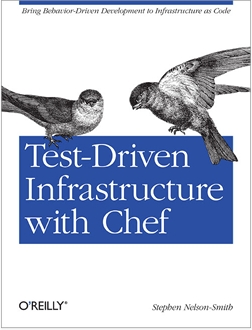A while ago I ordered a copy of “Test-Driven Infrastructure with Chef” from Amazon. It must have been sometime last summer in fact. It took months to arrive, because they simply didn’t have enough copies. So when it finally did arrive, I was very excited to see if my wait was worth the, er, wait.
Written by Stephen Nelson-Smith (he of @LordCope twitter fame and author of the excellent Agile Sysadmin blog), Test-Driven Infrastructure with Chef is by no means “War And Peace”. In fact it’s pretty tiny, and looks more like a pamphlet than a book. But what it lacks in size it more than makes up for in concise content.

What I really like about this book is that it feels absolutely perfect for someone like me, and by that I guess I’m trying to say that the target audience is well thought out. It’s aimed at Developers, Ops Engineers, DevOps, Sysadmins and Release engineers, those sorts of people. It assumes you know a certain amount about your own business, and so I don’t find myself sitting there reading some really basic stuff that anyone in my line of work is bound to know already. I’ll take the Continuous Delivery book as an example – it’s a great book, but some of it is about introducing Continuous Integration! I would have thought that if you were about to embark on Continuous Delivery, the first thing you’d already be VERY comfortable with would be C.I. so why the need to cover that all over again? Besides, there are plenty of good C.I. books on that subject. Of course, I know that the Continuous Delivery book is in actual fact aimed at a much wider audience, but what I’m trying to say here is that Test-Driven Infrastructure with Chef is more targeted, and I feel it’s a much easier read for it.
Infrastructure as Code
The fundamental premise of this book, and indeed the main point of Chef itself, is that we should treat infrastructure as code. What this means is that managing, designing, deploying and testing infrastructure should be done in an analogous fashion to how we do these same things with software. The code that builds, deploys and tests our infrastructure should be committed to source-control in the same way as the code that builds, deploys and tests our software is.
This approach brings with it many of the same principles as we have around building, deploying and testing our software, and these are listed in chapter 1. Also listed here are the advantages of treating your infrastructure as code, things such as repeatability, automation, agility, scalability, disaster recovery and very importantly, reassurance!
The book goes on to introduce the reader to Chef. Chef is an open source tool for managing, deploying and configuring infrastructure. It’s produced by Opscode – check out the website for more information. The book explains about the Chef tool, framework and API, and then goes on to give instructions on how to install it (you’ll need Ruby installed – and the book covers this, using RVM). You’ll also get an introduction to Git (and GitHub) here too, and how to install Git on Ubuntu. Incidentally, all the examples are based on an Ubuntu system, so if you follow the examples closely, it’s best to have Ubuntu, or an Ubuntu vm at hand. That’s not to say that the examples can’t be done on other systems, but I would guess that centos would require a lot more behind-the-scenes configuring, thanks to its less-than-fantastic package repositories.
Cucumber-Chef
Chapter 4 provides a nice introduction and description of Test-Driven and Behavior-Driven Development, and talks a little about the Acceptance Test automation tool Cucumber, before chapter 5 goes into some more detail about Cucumber-Chef (don’t worry if you haven’t heard about this before, the book tells you all you need to know to get started, but for now let’s just say it does for infrastructure what Cucumber does for code).

I couldn't find the logo for cucumber-chef, so here's a picture of a cucumber...

...and chef
Chapter 5 introduces us to the Amazon EC2 Web Service. It shows you how to get setup with a personal account (which is nice and easy), because you’ll need it to work through the examples that follow! This is one of the things that I like most about this book, it’s a practical guide, it’s as if the author knew (which he obviously did) that his target readers are the types of people who like to get stuck in and do stuff. Chapter 5 finishes off with instructions on installing Chef and using a couple of the built-in tasks.
Recipes, Roles and Cookbooks
It’s chapter 6 and time for a worked example using cucumber-chef. This is where we first meet Recipes, Roles and Cookbooks. First, we learn how to do cucumber style Given, When, Then Acceptance tests, and we start TDDing. This chapter really is about how to apply test-driven development to an operations solution. Requirements are gathered, Acceptance criteria are identified, Acceptance Tests are written (before we actually do any Chef scripting, as per TDD), and we follow the “Red, Green, Refactor” model until we have a working solution. In my copy there’s a glaring mis-print on page 48, where the given, when, then example ends up being “given, when, when” 🙂 Hopefully this’ll get corrected in future editions.
The final chapter underlines how managing our infrastructure as code, and applying the principles of test-driven development can help us increase our quality and reduce the usual risk associated with deploying infrastructure.
Conclusion
This book will serve as a great introduction to Chef for anybody who learns best via hands-on examples. But it’s much more than an introduction to Chef, it’s really about the practice of test-driven development, and about how to apply the principles of TDD to infrastructure management.
Using Chef in itself is a step in the right direction – it allows us to treat infrastructure as code, and this has so many benefits – we can version our configurations much more easily, we can store our configurations in a proper source code management tool, we can deploy configurations sensibly, and so on. And applying TDD principles to your Chef “development” obviously looks like a great idea, it brings with it all the goodness of TDD, and gets us to think in terms of requirements and acceptance criteria before we start building our systems, ensuring that what we produce is fit for purpose.
Even if you don’t follow TDD, or don’t plan to follow TDD for your infrastructure development, this book is still very much well worth the read. The hands-on approach using examples you can actually work with, is refreshing. I’ve probably learned more from working through this little book than I have from reading most other voluminous technical guides.



